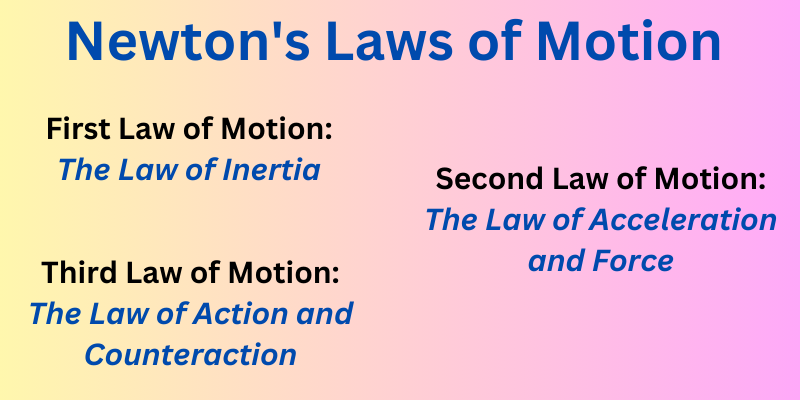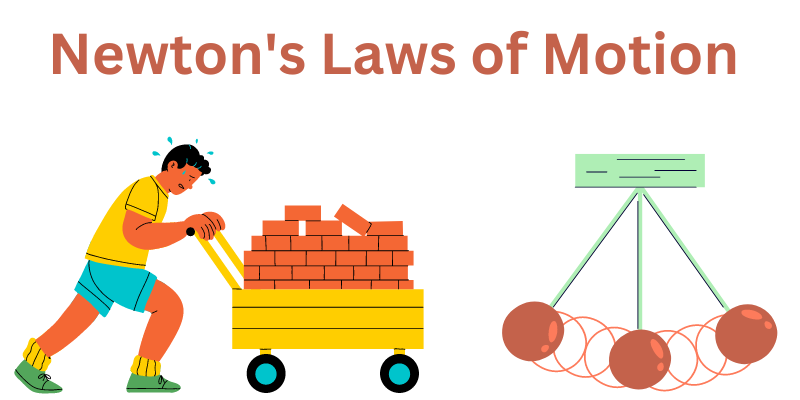Understanding the principles of motion is fundamental to physics, and at the heart of these principles lie Newton’s Laws of Motion. This blog will serve as a detailed guide, providing comprehensive notes on Newton’s laws, their implications, and real-world applications. Whether you’re a student preparing for exams, a teacher looking for resources, or a curious mind, these Newton’s laws of motion notes will clarify this essential topic.
Table of Contents
Introduction to Newton’s Laws of Motion
Newton’s laws of motion were formulated by Sir Isaac Newton in the 17th century, laying the groundwork for classical mechanics. These three laws describe how objects behave when forces act upon them. Understanding these laws is essential not only for physics students but for anyone interested in how the physical world operates.
Overview of the Three Laws

- First Law of Motion: The Law of Inertia
- Second Law of Motion: The Law of Acceleration and Force
- Third Law of Motion: The Law of Action and Counteraction
Each of these laws contributes to our understanding of motion and forces. In this blog, we will explore each law in detail, accompanied by examples and applications, ensuring that our Newton’s laws of motion notes are thorough and informative.
First Law of Motion: The Principle of Inertia
The First Law of Motion, called the principle of inertia, says that an object that isn’t moving will stay still, and an object that is moving will keep moving in a straight line at the same speed, unless something else pushes or pulls it. This law explains inertia, which is how much an object resists changing its motion.
Key Concepts of the First Law
- Inertia: This is the natural ability of an object to resist changes in how it moves. Heavier objects have more inertia, so they resist changes more than lighter ones.
- Equilibrium: When no overall force is acting on an object, it’s in equilibrium. This means its speed and direction stay the same.
Real-World Examples
- Stationary Objects: A book lying on a table will not move unless a force, like a hand pushing it, acts upon it. This illustrates that without external influence, objects do not change their state of rest.
- Moving Objects: A soccer ball rolling on a smooth surface will keep rolling until friction (an external force) eventually brings it to a stop. If the surface were perfectly frictionless, the ball would continue indefinitely.
These examples emphasize the importance of understanding inertia and the first law. Thus, they serve as practical references for our Newton’s laws of motion notes.
Implications of the First Law
The implications of the first law are profound. It challenges our intuitive understanding of motion, showing that motion does not require a continuous application of force. This principle is crucial in various fields, including engineering, where it influences the design of systems that must maintain motion without constant energy input.
Second Law of Motion: The Law of Acceleration and Force
Newton’s second law explains the connection between force, mass, and acceleration. It shows that if you want to change how fast something moves, you need to consider two things:
- Weight of the Object: Heavier objects require more force to speed up or slow down.
- Amount of Force Applied: The greater the force you use, the faster the object will accelerate.
So, if you push a light ball and a heavy ball with the same strength, the light ball will move much faster because it has less mass. This law helps us understand how things move in the world around us!
You can express this law using a mathematical formula like this:
$$F=ma$$
Where:
- \(F\) denotes the total force acting on the object,
- \(m\) is the mass of the object,
- \(a\) is the acceleration produced.
Key Concepts of the Second Law
- Net Force: This is the total effect of all the forces acting on an object. When different forces are applied, they can either combine to make a stronger force or cancel each other out.
- Acceleration: This is how quickly an object’s speed changes over time. It can happen if the object speeds up, slows down, or changes direction.
Real-World Applications
- Pushing a Shopping Cart: When you push a shopping cart, the harder you push (increasing force), the faster it accelerates. If the cart is loaded with groceries (increased mass), you must exert more force to achieve the same acceleration.
- Automobiles: Cars accelerate based on the net force produced by the engine. Heavier vehicles need more powerful engines to accelerate at the same rate as lighter ones.
The second law is fundamental in mechanics, providing the foundation for many calculations and analyses in physics, making it a critical element of Newton’s laws of motion notes.
Further Implications
The second law also implies that acceleration is directly proportional to the net force and inversely proportional to mass. This relationship helps us understand various phenomena, from how rockets launch into space to how objects behave in different environments, such as air or water.
Third Law of Motion: The Law of Action and Counteraction
Newton’s third law states that for every action, there is a reaction equal in strength and opposite in direction. This means that whenever one object applies a force to another, the second object pushes back with the same force but in the opposite direction. For example, if you jump off a small boat, you push the boat backward while you move forward!
Key Concepts of the Third Law
- Force Pairs: Every force has a corresponding counterforce that acts on a different object.
- Interaction: Forces are interactions between objects; they do not exist in isolation.
Real-World Examples
- Jumping Off a Boat: When you jump off a small boat, you push down on the boat (action), and the boat pushes you upward (reaction), causing it to move backward.
- Walking: As you walk, you push against the ground (action), and the ground pushes you forward (reaction), allowing you to move.
These examples illustrate the dynamic interactions dictated by the third law, which is crucial for Newton’s laws of motion notes.
Implications of the Third Law
The third law emphasizes that all interactions involve mutual forces. This principle is particularly important in understanding how systems operate, from simple activities like walking to complex systems like spacecraft maneuvering in space.
Applications of Newton’s Laws
Understanding and applying Newton’s laws of motion extends beyond academic pursuits; they have practical implications in various fields. Here are some notable applications:
Engineering
In engineering, Newton’s laws are fundamental in designing vehicles, buildings, and machinery. For instance, engineers must consider the forces acting on a bridge to ensure it can withstand traffic loads and environmental forces like wind.
Sports Science
Athletes utilize these laws to enhance performance. A sprinter must understand the forces acting on their body to maximize acceleration and speed. Coaches apply these principles to improve techniques and training methods.
Space Exploration
In space missions, Newton’s laws are crucial for calculating trajectories. For example, when a spacecraft launches, engineers must consider the forces acting on it to determine its path and ensure it reaches its destination.
Everyday Life
From driving a car to riding a bicycle, Newton’s laws govern our daily activities. Understanding these forces can help improve safety and efficiency in various tasks, such as navigating traffic or optimizing exercise routines.
These applications reinforce the importance of mastering Newton’s laws of motion notes for practical use in everyday situations and professional fields.
Common Misconceptions
As with any scientific concept, several misconceptions about Newton’s laws of motion can lead to confusion:
- Objects at Rest vs. Objects in Motion: Many believe that an object at rest is “lazy” or “inactive.” However, according to the first law, it simply maintains its state until an external force acts on it.
- Understanding Inertia: Some confuse inertia with weight. Inertia is a property related to mass, while weight is the force of gravity acting on an object.
- Action and Reaction Confusion: People often think action and reaction forces cancel each other out. While they act on different objects, they do not cancel each other in the context of motion.
By addressing these misconceptions, we can enhance clarity in Newton’s laws of motion notes and improve our understanding of these fundamental concepts.
Practical Activities for Learning
To reinforce your understanding of Newton’s laws, consider engaging in practical activities that illustrate these principles:
Experiment 1: Inertia in Action
- Objective: Demonstrate inertia using a coin and a card.
- Materials: A coin and a playing card.
- Procedure: Place the coin on top of the card. Quickly swipe the card away. Observe how the coin falls straight down, illustrating inertia.
Experiment 2: Force and Acceleration
- Objective: Explore the relationship between force and acceleration.
- Materials: A toy car, weights, and a ramp.
- Procedure: Place the toy car on a ramp and release it without additional weights. Measure the distance it travels. Then, add weights and repeat the experiment. Note the differences in distance, illustrating how mass affects acceleration.
Experiment 3: Action and Reaction
- Objective: Observe action-reaction pairs.
- Materials: A balloon and a string.
- Procedure: Inflate the balloon but don’t tie it. Let it go without holding the opening. Observe how the air rushes out one side (action), and the balloon moves in the opposite direction (reaction).
These practical activities can enhance your understanding of Newton’s laws and make the concepts more tangible, further enriching our Newton’s laws of motion notes.
Conclusion
In conclusion, Newton’s laws of motion provide foundational knowledge essential for understanding the mechanics of the universe. From the simplicity of the first law to the complexities of the second and third laws, these principles have far-reaching implications in science and everyday life.
As you reflect on these Newton’s laws of motion notes, remember their applicability in various contexts—from engineering and sports to space exploration and daily activities. A strong grasp of these laws not only enhances your understanding of physics but also empowers you to analyze and predict motion in the world around you.
Final Thoughts
To fully appreciate the beauty of physics, one must engage deeply with Newton’s laws of motion. They are not just theoretical concepts but practical tools that explain the forces and motions that govern our universe.
Revisiting these Newton’s laws of motion notes will help solidify your understanding and inspire further exploration into the fascinating world of physics. Whether you’re studying for exams, teaching others, or simply curious, mastering these concepts will serve you well in your journey through the physical sciences.
Thank You for Visiting Our Blog!
We are so grateful you took the time to explore our Newton’s Laws of Motion Notes! Your interest in our Newton’s Laws of Motion Notes truly motivates us to keep sharing valuable insights. We hope our Newton’s Laws of Motion Notes have enriched your understanding of the principles that govern motion.
Your engagement with our Newton’s Laws of Motion Notes is essential, and we love hearing your thoughts and questions. If you found our Newton’s Laws of Motion Notes helpful, we encourage you to dive deeper into our other blog posts as well!

